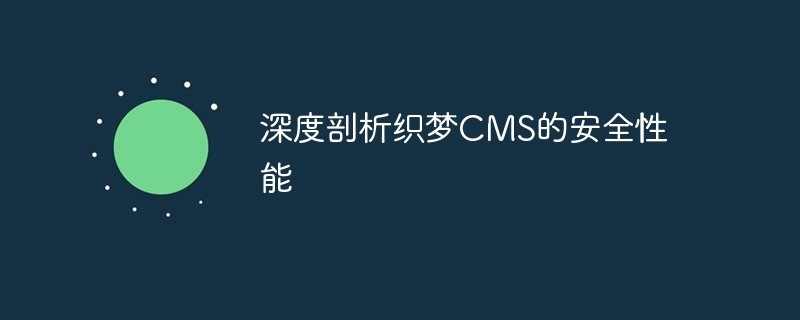Home >Backend Development >PHP Tutorial >An in-depth analysis of the security performance of DreamWeaver CMS
An in-depth analysis of the security performance of DreamWeaver CMS
- 王林Original
- 2024-03-28 22:03:021012browse

Title: In-depth analysis of the security performance of DreamWeaver CMS, specific code examples are needed
DreamWeaver CMS (DedeCMS) is a very popular content management system. Widely used in various website types. However, as network security issues become increasingly prominent, website security has become one of the focuses of users and developers. This article will conduct an in-depth analysis of the security performance of DreamWeaver CMS, discuss its existing security risks, and give specific code examples to improve website security.
1. SQL injection attack
SQL injection is one of the common means of network attacks. Attackers obtain database information and even tamper with data by injecting malicious SQL code into the input box. In Dreamweaver CMS, there are some vulnerabilities that may lead to SQL injection attacks, such as unfiltered user input.
Sample code:
// 漏洞代码 $id = $_GET['id']; $sql = "SELECT * FROM `dede_article` WHERE id = $id";
Improved code:
// 改进后的代码,使用预处理语句过滤用户输入
$id = intval($_GET['id']);
$stmt = $pdo->prepare("SELECT * FROM `dede_article` WHERE id = :id");
$stmt->bindParam(':id', $id, PDO::PARAM_INT);
$stmt->execute();2. XSS cross-site scripting attack
XSS attack is done by inserting malicious scripts into web pages. An attack method to steal user information or tamper with web content. In DreamWeaver CMS, failure to filter and escape user input data may lead to XSS attack vulnerabilities.
Sample code:
<!-- 漏洞代码 -->
<script>alert('XSS攻击');</script>Improved code:
<!-- 改进后的代码,对用户输入数据进行HTML转义 --> <div><?php echo htmlspecialchars($_GET['content']); ?></div>
3. File upload vulnerability
Dreamweaver CMS allows users to upload files, but does not control the uploaded files Type and size restrictions may lead to malicious file upload vulnerabilities, allowing attackers to upload malicious script files to execute attacks.
Sample code:
// 漏洞代码
$allowedTypes = array('png', 'jpg', 'jpeg');
$fileType = pathinfo($_FILES['file']['name'], PATHINFO_EXTENSION);
if (!in_array($fileType, $allowedTypes)) {
die('文件类型不允许上传');
}Improved code:
// 改进后的代码,限制文件类型和大小
$allowedTypes = array('png', 'jpg', 'jpeg');
$maxSize = 1024 * 1024; // 限制文件大小为1MB
if ($_FILES['file']['size'] > $maxSize || !in_array($fileType, $allowedTypes)) {
die('文件类型或大小不符合要求');
}As a powerful content management system, the security performance of Dreamweaver CMS is an important factor that website operators cannot ignore . By deeply analyzing its existing security risks and making improvements based on specific code examples, the security of the website can be effectively improved and user data and website information protected from malicious attacks. I hope the above content will help you understand the security performance of DreamWeaver CMS.
The above is the detailed content of An in-depth analysis of the security performance of DreamWeaver CMS. For more information, please follow other related articles on the PHP Chinese website!

